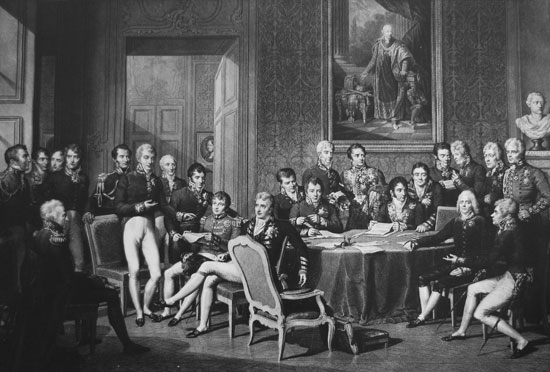The Congress of Vienna, convened in 1815, was a pivotal diplomatic conference aimed at reconstructing Europe post the Napoleonic Wars turmoil, striving for long-term peace and stability.
Background-
- Year- 1815
- Context- Following Napoleon’s defeat, the Congress aimed to restore European stability and order.
- Participants- Major European powers’ representatives, notably from Britain, Russia, Prussia, and Austria.
- Venue and Leadership- Hosted by Austrian Chancellor Duke Metternich in Vienna.
Main Objectives-
- Restoration- To reverse Napoleon’s territorial and political changes.
- Balance of Power- Ensuring no single country could dominate Europe.
- Legitimacy- Reinstating monarchies Napoleon had overthrown, thus upholding traditional monarchical and conservative values.
Key Decisions-
- Restoration of Monarchies- The Bourbon dynasty’s restoration in France, -overturning the French Revolution and Napoleonic changes.
- Territorial Adjustments-
- France returned territories gained under Napoleon.
- Buffer states like the Kingdom of the Netherlands (including Belgium) and an enhanced Piedmont (with Genoa) were established around France to thwart future expansion.
- Prussia and Austria received significant territories in the west and northern Italy, respectively, while the German Confederation of 39 states remained unchanged.
- Russia and Prussia expanded into Poland and Saxony, respectively.
Conservative Order-
- The Congress fostered a conservative order, valuing tradition, established institutions, and customs, and reinstating autocratic governance.
- It curtailed criticism and dissent, employing censorship to suppress revolutionary and liberal ideas.
Long-term Impacts-
- Balance of Power- The Congress’s efforts maintained European peace for nearly a century until World War I.
- Conservatism and Reaction- The era post-Congress saw a backlash against revolutionary and liberal movements, reinforcing conservative dominance.
- Nationalism and Unrest- Despite efforts to suppress nationalist sentiments, the Congress inadvertently set the stage for future nationalist and unification movements in Italy and Germany.
The Congress of Vienna significantly influenced the 19th-century European political landscape, championing conservatism, balance of power, and the legitimacy of traditional monarchies, shaping the course of European history for decades to come.
Also Check – The Role of Women in Nationalist Struggles – Short note
Also Check – The Frankfurt Parliament
Also Check – Liberalism: Economic, Political and Social Perspectives
Also Check – Romanticism- Class 10 – Chapter- The Rise of Nationalism in Europe
Also Check – How was the history of nationalism in Britain unlike the rest of Europe?
Also Check – Giuseppe Mazzini – Italian Revolutionary thinker
Also Check – Giuseppe Garibaldi- Italian freedom fighter
Also Check – Count Camillo de Cavour
Also Check – The Rise of Nationalism in Europe- 39 Mcqs
Also Check – The Rise of Nationalism in Europe – Class 10 – Notes
Also Check – Otto von Bismarck- Architect of German Unification
Also Check – Briefly trace the process of German unification
Also Check – Napoleon and the Napoleonic Code- Impact on European Societies and Legal Systems
Also Check – Why did Nationalist Tensions Emerge in the Balkans

